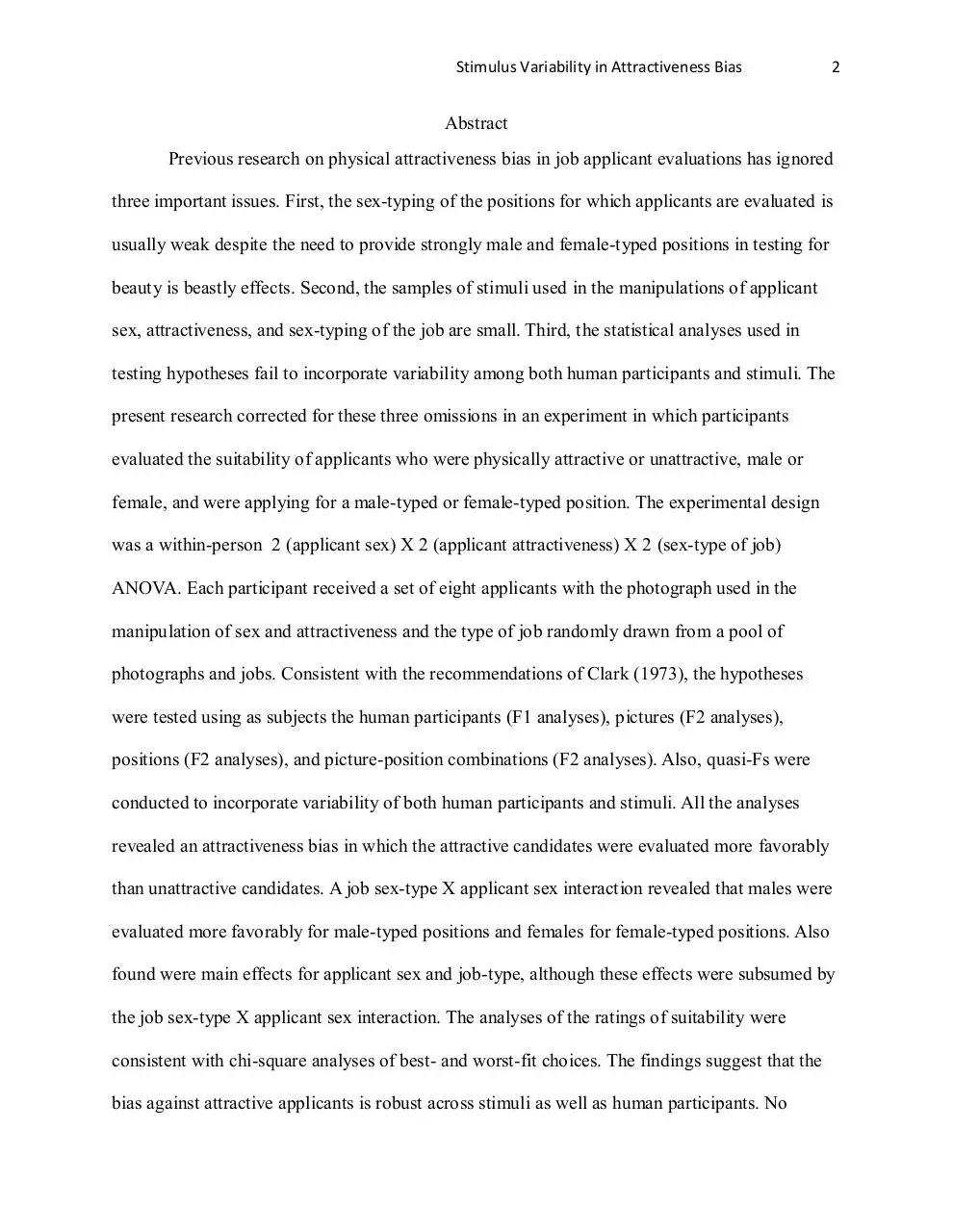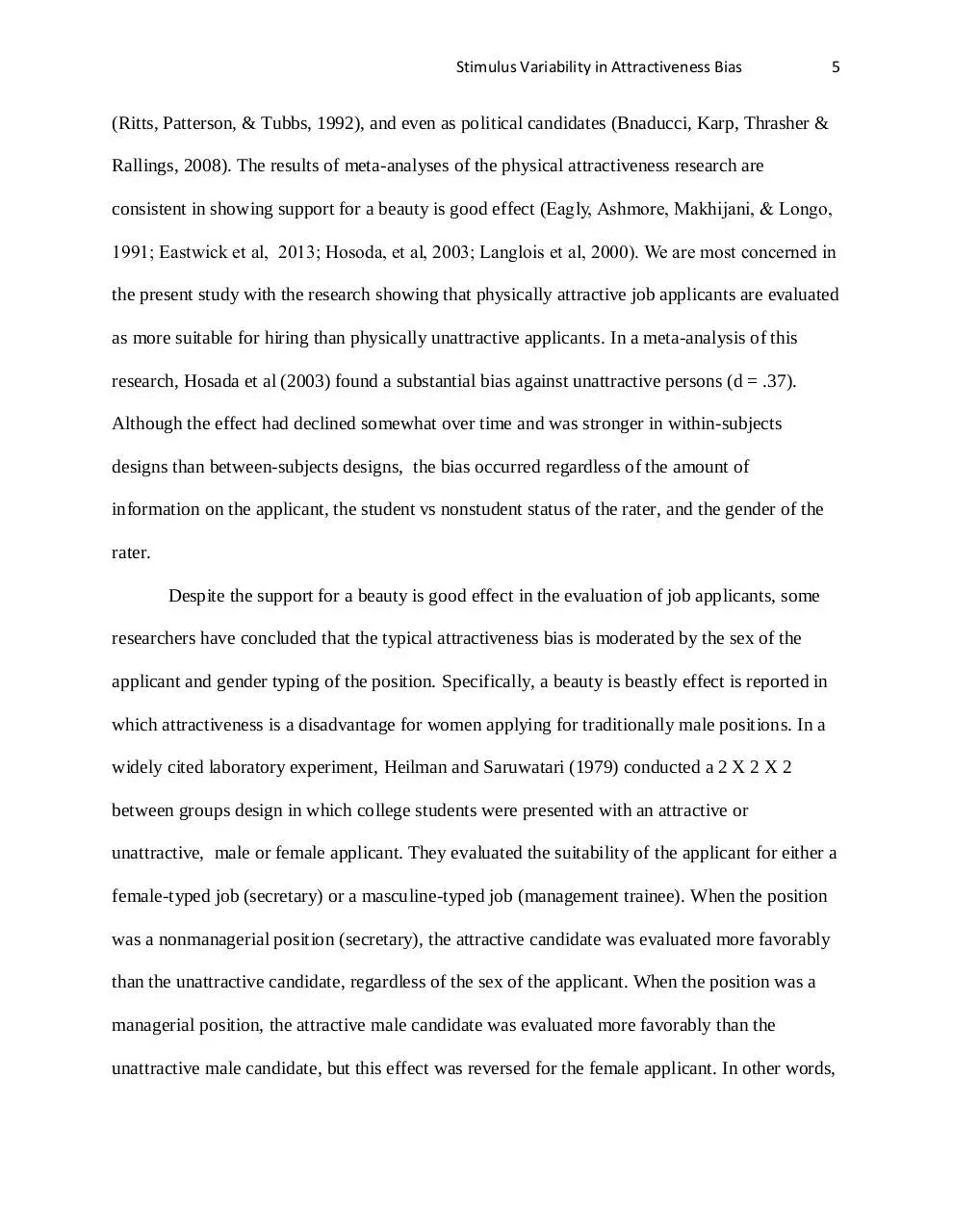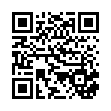Exploring Stimulus Variability in Applicant Attractiveness (PDF)
File information
Author: Robert Dipboye
This PDF 1.5 document has been generated by Microsoft® Word 2016, and has been sent on pdf-archive.com on 07/03/2017 at 19:02, from IP address 72.238.x.x.
The current document download page has been viewed 533 times.
File size: 559.53 KB (31 pages).
Privacy: public file





File preview
Stimulus Variability in Attractiveness Bias
Exploring the Effects of Physical Attractiveness in Job Applicant Evaluations:
Taking Into Account Stimulus Variability
Robert L. Dipboye and Lyndsey Dhahani
University of Central Florida
dipboye@rice.edu
This is a version of a paper (“The magnification, mitigation, and reversal of the physical
attractiveness effect”) presented at the August, 2013, Annual Meetings of the Academy of
Management, Orlando, Fl.
1
Stimulus Variability in Attractiveness Bias
2
Abstract
Previous research on physical attractiveness bias in job applicant evaluations has ignored
three important issues. First, the sex-typing of the positions for which applicants are evaluated is
usually weak despite the need to provide strongly male and female-typed positions in testing for
beauty is beastly effects. Second, the samples of stimuli used in the manipulations of applicant
sex, attractiveness, and sex-typing of the job are small. Third, the statistical analyses used in
testing hypotheses fail to incorporate variability among both human participants and stimuli. The
present research corrected for these three omissions in an experiment in which participants
evaluated the suitability of applicants who were physically attractive or unattractive, male or
female, and were applying for a male-typed or female-typed position. The experimental design
was a within-person 2 (applicant sex) X 2 (applicant attractiveness) X 2 (sex-type of job)
ANOVA. Each participant received a set of eight applicants with the photograph used in the
manipulation of sex and attractiveness and the type of job randomly drawn from a pool of
photographs and jobs. Consistent with the recommendations of Clark (1973), the hypotheses
were tested using as subjects the human participants (F1 analyses), pictures (F2 analyses),
positions (F2 analyses), and picture-position combinations (F2 analyses). Also, quasi-Fs were
conducted to incorporate variability of both human participants and stimuli. All the analyses
revealed an attractiveness bias in which the attractive candidates were evaluated more favorably
than unattractive candidates. A job sex-type X applicant sex interaction revealed that males were
evaluated more favorably for male-typed positions and females for female-typed positions. Also
found were main effects for applicant sex and job-type, although these effects were subsumed by
the job sex-type X applicant sex interaction. The analyses of the ratings of suitability were
consistent with chi-square analyses of best- and worst-fit choices. The findings suggest that the
bias against attractive applicants is robust across stimuli as well as human participants. No
Stimulus Variability in Attractiveness Bias
evidence was found for a beauty is beastly effect. Exploratory analyses suggested that a bias
against attractive females is limited to a narrow domain of jobs.
3
Stimulus Variability in Attractiveness Bias
4
Exploring the Effects of Physical Attractiveness in Job Applicant Evaluations:
Taking Into Account Stimulus Variability
Researchers have reported a bias against people who are relatively unattractive in their
physical features and a bias in favor of those who are relatively attractive in a variety of domains
(Eagly, Ashmore, Makhijani & Longo, 1991; Hosada, Stone-Romero & Coats, 2003). Moreover,
beauty is not in the eye of the individual beholder. Raters across diverse cultures appear to agree
on what constitutes facial attractiveness (Langlois, Kalakanis, Rubenstein, Larson, Hallam, &
Smoot, 2000) with the features of an attractive face including symmetry, averageness, and sexual
dimorphism (Rhodes, 2006). The cognitive interpretation of this “beauty is good” effect states
that the bias against unattractive persons is mediated by attributions of trustworthiness,
competence, social skill, and a variety of other positive traits (Eagly, et al, 1991; Feingold, 1992;
Jackson, Hunter, & Hodge, 1995; Langlois, et al, 2000). Another interpretation is that the bias in
favor of the attractive is rooted in unconscioius, affective responses that are hardwired as a
consequence of human evolution and associated with physical characteristics associated with
successful reproduction (Bzdok, Langner, Caspers, Kurth, Habel, Zilles, & Eickhoff, (2011).
One can extrapolate from this interpretation to propose that the bias against the physically
unattractive is so deeply rooted that it generalizes beyond mate selection to a variety of domains
including personnel selection.
Whether mediated by trait inferences or affective responses, the end result is to place the
physically attractive person at an advantage over relatively unattractive persons. This
discrimination has been demonstrated across a variety of domains. The physically attractive are
evaluated more favorably as romantic partners (Feingold, 1990; Eastwick, Luchies, Finkel, &
Hunt, 2013), as defendants in court trials (Mazzella & Feingold, 1994), as students by teachers
Stimulus Variability in Attractiveness Bias
5
(Ritts, Patterson, & Tubbs, 1992), and even as political candidates (Bnaducci, Karp, Thrasher &
Rallings, 2008). The results of meta-analyses of the physical attractiveness research are
consistent in showing support for a beauty is good effect (Eagly, Ashmore, Makhijani, & Longo,
1991; Eastwick et al, 2013; Hosoda, et al, 2003; Langlois et al, 2000). We are most concerned in
the present study with the research showing that physically attractive job applicants are evaluated
as more suitable for hiring than physically unattractive applicants. In a meta-analysis of this
research, Hosada et al (2003) found a substantial bias against unattractive persons (d = .37).
Although the effect had declined somewhat over time and was stronger in within-subjects
designs than between-subjects designs, the bias occurred regardless of the amount of
information on the applicant, the student vs nonstudent status of the rater, and the gender of the
rater.
Despite the support for a beauty is good effect in the evaluation of job applicants, some
researchers have concluded that the typical attractiveness bias is moderated by the sex of the
applicant and gender typing of the position. Specifically, a beauty is beastly effect is reported in
which attractiveness is a disadvantage for women applying for traditionally male positions. In a
widely cited laboratory experiment, Heilman and Saruwatari (1979) conducted a 2 X 2 X 2
between groups design in which college students were presented with an attractive or
unattractive, male or female applicant. They evaluated the suitability of the applicant for either a
female-typed job (secretary) or a masculine-typed job (management trainee). When the position
was a nonmanagerial position (secretary), the attractive candidate was evaluated more favorably
than the unattractive candidate, regardless of the sex of the applicant. When the position was a
managerial position, the attractive male candidate was evaluated more favorably than the
unattractive male candidate, but this effect was reversed for the female applicant. In other words,
Stimulus Variability in Attractiveness Bias
6
beauty was beastly in that the attractive female applicant was apparently denigrated relative to
the unattractive female applicant. The authors explain this effect with a person-job fit model that
emphasizes the cognitive mediators of attractiveness bias. They hypothesize that attractiveness
has the effect of enhancing the perceived femininity of the attributes of the female candidate. As
a consequence, the attractive female applicant is seen as providing a poorer fit to the masculinetyped managerial position than the unattractive female applicant.
Despite the growing volume of research on the effects of physical attractiveness on
evaluations of job applicants, there are three limitations in the previous research that cast some
doubt on the robustness of attractiveness biases in evaluations of job applicants. One issue
concerns the gender-typing of the male and female positions used in examining the effects of
applicant sex and attractiveness. To determine whether attractiveness benefits or harms an
applicant, it is important to have participants rate applicants on their qualifications for strongly
sex-typed male and female positions. Based on the job-fit model that Heilman et al (1979)
proposed in the original demonstration of the beauty is beastly effect, a bias against attractive
female applicants occurs when the position is strongly typed as a male-typed job requiring
masculine traits and occupied mostly by men. The beauty is good effect occurs when the position
is a female-typed job requiring feminine traits and occupied mostly by women. Notwithstanding
the importance of the gender-typing of the position, few studies provide a manipulation of the
sex-type of the position, with many using moderately sex-typed or gender neutral positions or
not even specifying the nature of the position.
The second issue concerns the sampling of the stimuli used in depicting the applicant and
the position. Researchers typically have used very few stimuli to manipulate attractiveness and
gender of the applicant. Although the procedures used in selecting the photographs used in the
Stimulus Variability in Attractiveness Bias
7
manipulation of sex and attractiveness are usually rigorous, only a few photographs are typically
used to represent the attractive and unattractive, male and female applicants. Stimulus sampling
is even more of a problem with regard to the positions for which applicants are evaluated. When
there is a manipulation of job sex-typing, only one position typically is used to reflect the maletyped and female-typed positions. The use of narrow stimulus samples poses several potential
threats to the validity of the interpretations of experimental findings. First, narrow samples risk
confounding the manipulation with factors associated with the stimuli used to represent
experimental conditions. If the one or two photographs used to represent the unattractive
condition depicted a person dressed inappropriately for an interview whereas the photographs
representing the attractive condition depicted more appropriate clothing, appropriateness of the
dress is a confound that may account for effects of the manipulation rather than facial
attractiveness. Second, narrow samples pose a threat to the generalizability of the findings across
a broader range of stimuli representing the manipulated variable. For instance, if the attractive
female condition was depicted with a glamour shot of a blonde, Marilyn Monroe type applicant,
one might not be able to generalize the effects to other types of female attractiveness (e.g., a
highly competent looking but attractive applicant).
The third issue concerns the statistical analyses conducted in previous research on
attractiveness bias. Even when more than one stimulus is sampled, none of the previous research
has incorporated stimulus variability in the statistical tests. When more than one stimulus is used
to depict each condition, the evaluations of each stimulus are aggregated in assessing the
statistical significance of differences between conditions. In these analyses, the aggregated rating
of the stimuli is used as a fixed-effect rather than including variability in ratings among stimuli
and treating the manipulation as a random effect. The effects of variables manipulated with
Stimulus Variability in Attractiveness Bias
8
stimuli such as photographs and job titles may prove less robust when stimulus variability is
incorporated in the statistical tests of the hypotheses.
The issue of stimulus sampling has been raised several times as a potential problem in
psychological research. Clark (1973) originally drew attention to this issue in a criticism of
verbal learning research. He noted that limited samples of words were typically drawn and
results were analyzed using a fixed effects ANOVA. He recommended the use of larger word
samples and the use of analyses that take into account variation across stimuli as well as
participants. The failure to account for stimulus variability in statistical tests of hypotheses is
also a potential problem in experimental research in both social psychology (Judd, Westfall &
Kenny, 2012) and industrial and organizational psychology (Fontenelle, Phillips & Lane, 1985;
Highhouse, 2009). Typically, a fixed effects analysis of variance is used to test for the statistical
significance of the effects of the manipulations (referred to as F1). Despite the variation in
stimuli sampled in creating each condition (e.g., attractive female applying for a managerial job),
the different stimuli are considered equivalent. In other words, a fixed effects model assumes that
variability in the photographs and job titles used to represent each condition does not matter or
that the stimuli chosen represent the population of all possible stimuli that one could have used.
The study using the larget and most diverse set of stimuli in the manipulation of sex,
attractiveness, and sex-type of job was conducted by Johnson et al (2010). In their study 1, an
F2 analysis was conducted in which photograph was used as participant. A set of eight raters
evaluated attractiveness of 204 (102 male, 102 female) pictures. Each picture was categorized as
attractive or unattractive based on the median split on ratings of attractiveness. Another set of 67
raters evaluated the sex-type of each of 26 jobs. Based on the median rating of sex-type, each job
was categorized as a male-type or female-type job. Finally, another set of eight raters evaluated
Stimulus Variability in Attractiveness Bias
9
the suitability of employment of each picture for 4 of the 26 jobs and the mean of ratings of each
set of eight raters constituted the dependent measure. A total 96 raters participated in this phase
of the research but only the mean ratings of suitability of each picture/applicant was used as the
dependent measure. Thus, the picture constituted the subject with ratings aggregated across
human participants. Using the picture as subject, a 2 (sex of picture) X 2 (attractiveness of
picture) X 2 (sex-type of job) X 2 (importance of appearance to job) within subjects analysis of
variance was conducted on the mean ratings of employability suitability for each photograph.
The researchers found an attractiveness bias in which attractive candidates were rated more
positively than unattractive candidates. and a sex X job type interaction in which males were
rated more favorably for male-typed jobs and females for female-typed jobs. The researchers
found no evidence of a beauty is beastly effect but did find a three-way applicant sex X
attractiveness X job-type interaction in which attractiveness provided somewhat less benefit for
women applying to a masculine position. Although Johnson et al (2010) provided a larger
sample of stimuli, they did not conduct statistical analyses that incorporated ariability in both
stimuli and human participants as recommended by Clark (1973) and Fontenelle, et al (1985).
Despite the frequent admonitions to provide a larger sample of stimuli and to statistically
account for stimulus variability, these recommendations are largely ignored in the research on
attractiveness biases in the evaluations of job applicants. Pursuant to correcting for the
deficiencies in previous research, the present study incorporated three methodological
modifications in the test of the hypotheses.
1. A stronger test of the “beauty is good” and “beauty is beastly” hypotheses was
implemented by examining the effects of target attractiveness on evaluations for female typed
and masculine typed jobs.
Download Exploring Stimulus Variability in Applicant Attractiveness
Exploring Stimulus Variability in Applicant Attractiveness.pdf (PDF, 559.53 KB)
Download PDF
Share this file on social networks
Link to this page
Permanent link
Use the permanent link to the download page to share your document on Facebook, Twitter, LinkedIn, or directly with a contact by e-Mail, Messenger, Whatsapp, Line..
Short link
Use the short link to share your document on Twitter or by text message (SMS)
HTML Code
Copy the following HTML code to share your document on a Website or Blog
QR Code to this page

This file has been shared publicly by a user of PDF Archive.
Document ID: 0000565432.